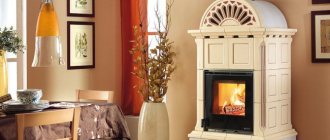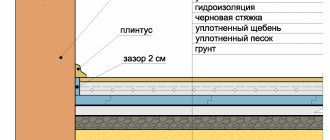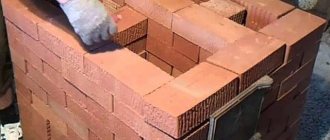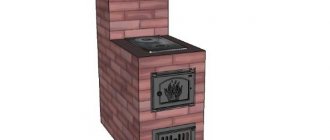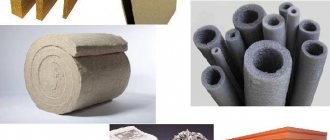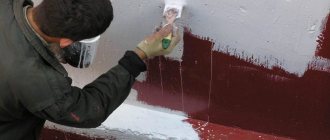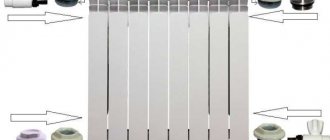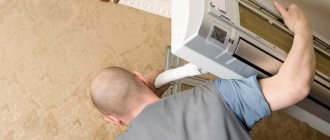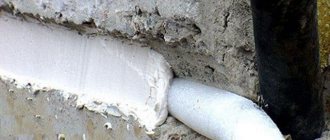The fireplace insert is understood as a separate part in which the fire burns and the maximum heating of the system occurs. It includes:
- frame;
- doors;
- smoke collector;
- chimney:
- grate;
- ash box.
If the firebox is a closed type, the doors can be made of special glass ceramics that can withstand very high temperatures.
The smoke collector is installed at the very top, in the area where smoke accumulates. A chimney is connected to it.
The grate is installed inside. An ash box is installed under it to collect ash and remains of unburned firewood.
Cast iron fireplace inserts are equipped with a double back wall, which can be replaced if necessary.
The steel firebox is lined with fireclay bricks inside, which protects the steel from deformation at high temperatures.
Materials
This question is very important when choosing a firebox. It determines how long the product will last.
Basically, the firebox is made of cast iron. This material has high heat resistance. It is constantly used to create fireplace equipment. Typically, cast iron plates are installed for small-sized products. Their assembly is carried out using fireproof sealant, as well as special fasteners.
Cast iron easily tolerates high temperatures. Therefore, it is used to create grates. They are installed in almost every combustion system. Moreover, it does not matter at all what the body and its internal lining are made of.
Large products are made of special, heat-resistant steel. This material is distinguished by its reliability. It can be safely used for a long period of time.
A deflector, the so-called “chimney tooth,” is made from stainless steel .
Fireclay is used to accumulate heat. They are used to cover heating units installed in a steel casing. Fireclay, in the process of fuel combustion, accumulates heat, which slowly moves into the room. In addition, fireclay lining protects the steel body. She doesn't let him overheat.
Vermiculite, similar to fireclay, is used for internal lining. It also protects the steel body and prevents it from overheating. The material differs from fireclay in its ability to reflect heat. The room heats up much faster.
Almost every fireplace insert is equipped with heat-resistant glass made from special vitroceramics. Such glass can withstand heat of 750 degrees.
Which firebox should I choose?
Open fireplace inserts The main advantage of open fireplaces is the opportunity to admire the live fire and feel the heat from the firebox, but the heat does not stay in the room for long and most of the hot air quickly flies away into the chimney. Due to the low efficiency of such models (only 15-20%) and the increased air consumption of an open firebox (up to 360 cubic meters / 1 cubic meters per hour), which requires a constant flow of air, it is not rational to use them for constant heating of housing .To avoid drafts, hypothermia, and sometimes smoke in the room, there is a limit on the size of the external opening of the firebox relative to the size of the room in which the fireplace is installed. With a ceiling height of about 2.5 m, the area of the firebox opening should be related to the area of the room approximately 1:75.
Open flames and sparks are fire hazards without a specially equipped safety area made of sheets of metal or ceramic tiles, etc. Heat-resistant materials are indispensable in residential premises. And the formation of more soot as a result of fuel combustion entails the need to increase the cross-section of the chimney.
In addition, it should be borne in mind that as a result of burning out more oxygen from the room, there is a danger of carbon monoxide poisoning due to the possible lack of a constantly necessary increased air flow, clogging of the chimney, any other malfunction or improper operation of open fireplace inserts (reverse traction).
Therefore, the conversation will mostly focus on closed fireplace inserts.
Closed fireplace inserts:
Firebox material: steel and cast iron .
Modern manufacturers of fireplace inserts primarily use cast iron and steel. Each of these materials has its own advantages, different levels of strength and resistance to the highest temperatures. Accordingly, both the operational characteristics and the cost of the fireboxes differ. Therefore, when choosing a fireplace insert, it is important to take all these characteristics into account.
Cast iron accumulates heat and releases it slowly. Steel heats up quickly and cools down quickly, so steel fireboxes often have an internal lining of cast iron plates, fireclay, vermiculite, Keramott , etc.
Cast iron is a durable and deformation-resistant metal with high heat transfer, resistant to temperature changes and burnout, better withstands long-term thermal loads and retains heat longer than steel, this is its main advantage. And high-quality cast iron (which is free of shells and foreign inclusions) is durable - the parts do not deform during alternating heating and cooling. Without re-sealing, they will last up to 30 years ; the continuous burning time of such a firebox is quite long - up to 24 hours . Cast iron fireboxes are preferred if they want to obtain more heating power. During the combustion of wood, heat accumulates in a cast iron firebox and is released into the room for quite a long time. With the same parameters, cast iron fireboxes have a lower price, which is due to their manufacturing technology.
Disadvantages: Cast iron products are quite heavy. That is why the manufacture of large fireboxes from cast iron is impractical. Cast iron fireboxes of prefabricated construction lose their tightness over time, as a result of which the combustion process becomes unregulated (the air flow for combustion increases, the combustion temperature rises, the thermal wear of the firebox body accelerates, and there is also a risk of flue gases leaking into the living room.
Modern steel fireboxes, as a rule, have a combined
frame.
body
is made of heat-resistant steel, usually 3 mm thick. Alloying additives (chrome, nickel, nitrogen) increase strength, corrosion resistance, and reduce the risk of brittle fracture. The internal thermal insulation of steel fireboxes protects the body from deformation at maximum temperatures and does not allow the steel to burn out. Steel fireboxes can be heated continuously for several days in a row, and they heat up faster; this is especially important in winter. The welded body significantly increases the tightness of the fireboxes (up to 98%). This guarantees good, controlled combustion, constantly clean glass, economical use of firewood, excellent visibility of the fire, because The glass sizes in steel fireboxes are significantly larger compared to cast iron ones.
The significant advantages of steel fireboxes are: a large range of models, a variety of shapes and large sizes of fireboxes, including design delights, and the ability to replace elements of the internal lining.
Combined fireboxes are made simultaneously from several materials. The principle of duplicated or double body fireplace inserts is designed to get rid of the main disadvantage of cast iron prefabricated fireboxes. To solve this problem, special heat-resistant steel was used. The essence of the concept is as follows - the firebox body consists of two bodies - outer and inner, as if nested one inside the other. At the same time, the first is external, all-welded, made of ductile steel, which allows you to maintain the tightness of the firebox for many years, and the second - internal, made of heat-resistant cast iron or fireclay/ceramic lining (or combined), protects the first body from direct exposure to high temperatures, creates a decorative effect (eg brickwork) and can be easily replaced from the inside. Thus, a more modern technology for the production of fireplace inserts was created, which is now used by the vast majority of manufacturers when creating their products. The service life of such fireboxes has also been increased.
A lining made of heat-resistant material protects the steel body from deformation at maximum temperatures and does not allow the steel to burn out. Fireboxes can be lined with cast iron, fireclay, vermiculite, keramott, etc.
Cast iron , due to its heavy weight and the emergence of new innovative materials, is used less and less.
Chamotte is a refractory clay, a crushed component of fireclay masses. Fireclay mass made from refractory clay has increased strength characteristics, fire resistance and fire resistance, and is absolutely harmless to humans, animals and plants.
Vermiculite —
slab constructional non-combustible material, with high heat and sound insulation properties, heat resistance and reflectivity. Chemically inert, neutral to the action of alkalis and acids, environmentally friendly and sterile. Odorless, non-toxic, non-rotting, prevents the spread of mold and does not contain heavy metals.
Keramott - unlike fireclay, vermiculite and other lining materials, has an ideal balance between thermal insulation and adaptive thermal conductivity (the higher its temperature, the greater its thermal conductivity), which allows you to quickly obtain a high combustion temperature of firewood and maintain the temperature inside the firebox at an almost constant level . Guaranteed to provide “clean” combustion with low emissions. When a certain temperature is reached, the combustion chamber of fireboxes and stoves is capable of “self-cleaning” - Keramott, when used correctly, always remains clean and bright.
| Chamotte | Vermiculite | Keramott | |
| Ignition | takes the temperature | high insulating properties | high insulating properties |
| unclean combustion, risk of glass contamination | rapid achievement of operating temperature | rapid achievement of operating temperature | |
| clean combustion, good glass cleaning | clean combustion, good glass cleaning | ||
| Combustion | strong radiation into the firebox | strong radiation into the firebox | increasing thermal conductivity |
| low efficiency | low efficiency | high efficiency, good thermal radiation from the firebox | |
| high flue gas temperature | high flue gas temperature | uniform temperature inside the firebox |
Power
Power is the main parameter that determines the feasibility of purchasing a particular firebox. To choose the right product, you need to calculate the volume of the room that needs to be heated, and also determine the purpose of using the fireplace - as a main or additional heating device.
A distinction is made between the maximum and rated power of the device.
The maximum is measured during operation in a short period of time and in almost ideal conditions: wood humidity is 15-20%, optimal chimney and excellent thermal insulation of the room. As a rule, such conditions cannot be achieved in practice, so the maximum power indicator should be used as a guide only.
The rated (average) power of the equipment, measured experimentally during laboratory tests, is approximately 30% lower than the maximum.
Respectable manufacturers of fireboxes certify their fireboxes in the nominal mode, that is, in the one in which the firebox will operate at its best performance. However, some manufacturers, mostly with a low reputation, trying to attract potential buyers, deliberately certify their fireboxes to be high and indicate an overestimated power, thereby misleading them.
However, it is the rated power that allows you to calculate the area of the room that a particular firebox can heat, and you should focus on it when choosing a firebox.
It is conventionally accepted that 1 kW will heat 10 square meters. rooms with a ceiling height of 3 m.
For example
, a firebox with a maximum power of 14 kW will normally heat 90-100 square meters. area, and only occasionally (in maximum mode) is it capable of heating up to 140 square meters. It must be remembered that long-term operation of the firebox at maximum power mode leads to increased wear.
If you want to make not an approximate, but a more accurate calculation of heating, it is recommended to take into account climatic features
.
For example,
for heating 10 sq.m. Average area required:
- in central regions ( Moscow region)
1.2-1.5 kW; - in the northern regions - 1.5-2 kW;
- in the south - 0.7-0.8 kW.
The quality of fireplace heating in a house will depend not only on the heated area (volume), but also on the quality of insulation and the climate zone in which the room is located. Based on French standards, each kW rated
power of a closed fireplace insert or stove-stove, will heat the air:
- 14 cubic meters in a house without insulation, in a cold climate zone,
- 20 cubic meters in a normally insulated house in a temperate climate zone,
- 33 cubic meters in a house with excellent insulation or a warm climate zone.
In the post-Soviet space, it is generally accepted that 1 kW of fireplace insert power will heat, on average, 25 cubic meters. air in the house 2 hours before a comfortable temperature.
Efficiency
The efficiency of fireplace inserts and stoves, along with power, is a thermal indicator of the efficiency of the fireplace and, in fact, should be defined as the ratio of the amount of thermal energy transferred from the fireplace insert to heat the room to the amount of energy that can be obtained by completely burning wood, expressed as a percentage, however, they may vary depending on operating conditions. Therefore, according to Din EN 13240, the efficiency of a fireplace insert is determined by other indicators.
Nominal power values and efficiency are indicated in the heating device passport, and can be:
- open fireplaces 20-40%;
- closed fireplace inserts 65-85%;
- heater stoves for baths 35-55%;
- potbelly stoves 30-70%;
- heating and cooking stoves 50-80%;
- fireplace heaters 60-80%;
- ovens up to 85%.
High efficiency saves fuel costs and is good for the environment, and according to European standards, the efficiency for wood stoves from 01/01/2015 must be at least 80% .
It is difficult to compare heating devices in terms of efficiency, since the combustion modes, wood consumption and heating systems are different: an open brick fireplace emits heat only after the entire surface of the brickwork has been heated; in brick stoves, the entire structure, including chimney channels (smoke circulation), is involved in the heating process, and in a fireplace insert, heating occurs due to air convection and, at the same time, uniform cooling of the surface of the firebox.
When choosing a fireplace insert (stove), it is worth considering the amount of thermal energy that can be obtained from this model. Many fireplace inserts that have the same characteristics, at the same time have distinctive features and their own individuality. There are a lot of nuances and when choosing a fireplace insert it is better to seek qualified advice. However, to do this, first of all, you should definitely decide on your preferences: for you, a fireplace is an aesthetic pleasure from contemplating an open fire, or a decorative heating function, or a traditional source of heating.
The presence of a large and heat-intensive lining does not increase the efficiency and power of the fireboxes; it only increases the heat capacity and, accordingly, the time of heat radiation. You can increase efficiency (and power accordingly) when it is possible to remove additional heat from the chimney. Hot gases passing through the chimney are able to release even more thermal energy thanks to the use of heat storage devices.
Possibility of connecting heat storage devices.
Steel fireboxes, unlike cast iron, due to their greater thermal conductivity, heat up faster, which allows you to warm up the room much faster (this is especially important in winter), but they also cool down much faster. In order to eliminate this significant drawback, ready-to-install heat storage systems can be used to improve the heat storage capacity (increase heat transfer) of steel fireboxes. The heat-storing mass, located as close as possible to the combustion chamber, allows you to get the maximum from the loaded fuel and save heating costs, and also makes it possible to radiate heat quickly, but without overheating the room, but rather releasing it gradually, providing a pleasant and healthy long-term heat radiation.
If the main heating is turned off, a properly selected system will allow you to heat the entire house with one fireplace.
What heating systems can do
The composition of the firebox sold in the store usually includes:
- Ash box.
- Cast iron grate. Air is supplied under the grate, fuel combustion intensifies.
- Deflector. Installed to protect the chimney from direct ingress of flue gases. As a result, productivity increases.
- Smoke collector. Made from cast iron or steel. Each manufacturer chooses the type of material, it all depends on the technological process used.
- Lining. Can be made of fireclay. Sometimes cast iron plates are used. Vermiculite is used to replace fireclay. Almost every modern model is a mechanical design that includes:
- Air supply regulator.
- Afterburning system. Increases air supply. The remaining small particles burn out. Product performance increases and fuel consumption is significantly saved.
- Glass cleaning mechanism. The air in the system begins to heat up. A free space is formed between the burning flame and the glass, which protects the glass from soot settling.
What to look for when choosing inexpensive fireplaces
All fireplace inserts can be roughly divided into three categories: cheap, mid-price and expensive. The point is mainly not in the manufacturer and his name, but in the quality and technologies that are used. There are no miracles. It is impossible to buy a cheap fireplace insert with the same performance as an expensive one. But there are better and worse models in every price range. And, with the same price, the quality can vary significantly. What is typical is that the higher the price range, the fewer differences between products from different manufacturers. So if you want to choose from cheap ones, carefully inspect the models you choose.
The price range is amazing
The first and most important thing is the quality of the metal. If it is steel, make sure it is heat resistant and check the quality of the seams. They must be smooth, without sagging, cavities, etc. The quality of cast iron is checked by external inspection. The smoother the casting, the higher the quality. The wall thickness of steel and cast iron fireboxes is also important. Especially on the vault, where the heat load is highest. There should be a maximum thickness.
Firebox tightness
First and most important, the fireplace insert must be airtight to operate effectively. Then it can operate in any mode - active combustion, smoldering, etc. This is what distinguishes expensive models from cheap ones: the degree of sealing. Therefore, when choosing a budget model, pay attention to the ability to regulate the air supply.
- Air supply system. Air is usually supplied through the ash pan. Grooves are made under the door, which are overlapped by movable flaps. Lever at the bottom or side. By opening and closing the air supply, we adjust the combustion intensity. There may be several adjustments, but they all make sense if they allow you to completely shut off the flow. Check how well they fit and how reliably they block air access.
What to look for to ensure that your fireplace insert is of good quality
- Door seal. Made from ceramic cord and goes along the perimeter without gaps. Not from below, not from two or three sides. The cord should be wide (extend further beyond the frame) and soft. If it has lost elasticity or is made flush with the groove in a new firebox, there will be no tightness.
- How the glass is pressed to the door frame. If the pressure is only applied by several holders, air will flow in. Ideally, a metal corner that is pressed with holders. And one more thing: the holders must be reliable, made of good metal (you won’t be able to bend them with your fingers).
- Glass seal - along the entire perimeter between the glass and the door frame. Better is the same ceramic cord, but flatter. The sealant is not bad, but the cord is better.
Sealing the glass and the door itself is very important for saving fuel
- Glass cleaning system. These are the holes at the top of the door frame above the glass. Air enters through them and falls down, carrying away soot and fumes. This way the glass stays clean longer. Please note: the glass will still need to be cleaned occasionally.
- Method of opening a chimney damper. The cheapest is bolted, but also the most unreliable. If a bolted connection is selected, provide access during installation for repairs and replacement of bolts/nuts.
As you can see, there are enough parameters and these are just the main ones. There is still that same beauty. If your budget allows, choose a frameless door. They look much more solid, although they cost more.
Fuel efficiency
If the fireplace will be used for heating, and not just for beauty, its efficiency is important. It will be economical when the heat is extracted to the maximum. Therefore, we pay attention to the presence of a secondary air supply.
Air is usually supplied through a grate. It goes to firewood, it burns. The process produces more gases. For the most part, they are flammable and their heat of combustion is greater than the heat we get when burning wood. If you ignite these gases, there will be much more heat. To set them on fire, just add oxygen.
Gas is blazing under the roof - this is afterburning of gases
To do this, holes are made in the back wall and in the top of the firebox. This is the secondary air supply - for afterburning gases. Air is supplied to the upper part of the firebox and mixed with hot gases. This mixture ignites, which provides additional heat. This process can be observed. When burning, a cap of fire forms in the upper part of the firebox. But let us draw your attention once again - this makes sense in a sealed firebox, where the air supply (and the oxygen it contains) is normalized.
Features of guillotine fireplaces
If you are interested in a fireplace insert with a vertical opening, then you will also need to choose the mechanics of the lifting mechanism. Such models can no longer be classified as cheap - the mechanism itself is quite expensive. There are three opening options:
- rollers;
- cable;
- chain.
Roller skates are the most convenient. Smooth running, little effort required. The rollers are made of metal that tolerates overheating well, but can wear out over time. This will make opening more problematic.
Guillotine fireplaces are not cheap
There is also a chain and cable that are pulled through a system of wheels and sprockets. The chain is more reliable, but noisier - it rings when moving. The cable glides silently, but when heated it can stretch more, which can complicate the process. It is impossible to say for sure that some of the systems are more reliable and some less. What is certain is that the chain is noisier. If this is critical for you, choose a cable or roller mechanism.
Glass: double, triple or mirror
The closed fireplace insert has a large area of glass. If there is single glass, it emits a lot of heat. To reduce the amount of heat that penetrates through the glass, double or triple glass is used. The second option is with mirror coating. Heat is reflected into the firebox, which increases the temperature, which leads to more complete combustion of the fuel.
Glass must protect against excessive heat
What's better? Spraying is more effective, but also more expensive. Double glass is cheaper, although it works worse. But double or triple glass helps it stay clean longer. Although, this depends more on how well the self-cleaning system is made.
What shape do the glasses have?
Several types of glass are installed in fireplace inserts:
- Direct. Considered the standard option. Manufactured for fireboxes of any size.
- Prismatic. This shape of glass refracts the appearance of the flame. A beautiful picture is created, the view of the blazing fire becomes much larger. Such models look great in a wall-mounted fireplace or corner system.
- Spherical. There is no refraction of fire. The curved shape increases the visibility of the flame. Sometimes the radius of the glass is made very large. As a result, the sight of the flame turns into an incredibly beautiful picture. A firebox with such glass can be installed in a corner of the room or near a wall. With a radius of more than 180 degrees, the firebox will look great in the center of the room.
- L-shaped glass. It can be left-handed or vice versa, right-handed. Corner installation possible.
- Double-sided glass. This type received an additional name: “through glass”. This product helps to zone the room.
- Three-sided glass. A wall-mounted installation option is best suited.
What does the cost depend on?
When setting the price of a heating system, several parameters are taken into account:
- application of the latest technologies;
- model dimensions;
- panoramic glass size;
- how the doors open. There are models with side opening or top lift. These mechanisms provide free access to the glass from the inside;
- The firebox is equipped with a special convection casing. It must have holes and welded pipes so that corrugated pipes can be connected. With their help, convection air is directed to other rooms;
- water circuit of any type;
- decorative design of door frames.
Selecting the furnace configuration according to the type of heating system
Depending on the planned heating system and the needs of the resident of the house, the configuration of the fireplace cassette is selected.
- Heating of one or two rooms: a standard cassette with holes for convection air outlet
- Air heating: selecting an insert with pipes for connecting air ducts: distributing heated air to selected rooms. Allows you to heat several or more rooms
- Water heating: choosing an insert with a hydraulic circuit, a heat exchanger and a pipeline system through which the heated coolant (water) enters the radiators, radiators, boiler and heated floors. The most effective configuration of the firebox, as it allows you to organize an autonomous heating and hot water supply system for the entire house.
Attention! Based on the type of heating system, the total footage of the house and its layout, as well as the number of rooms that are planned to be heated, the power of the cassette is selected, which is presented in a wide range.
Performance calculation
In order to obtain maximum efficiency of the firebox, it is necessary to correctly calculate the thermal power. If the calculation is done correctly, the fireplace can become the main heating system. When calculating performance, you must take into account several very important indicators:
- The level of thermal insulation of the room. If the home's insulation is poor, then a more powerful firebox will be required.
- Room volume. For a room of 200 cubic meters. meters, the furnace power must be at least 8 kW. If the volume of the room reaches 250 cubic meters. meters, a firebox with a power of 10 kW is installed. When using a fireplace as an addition to the interior, its power may be lower;
- Product configuration. Fireboxes usually differ in appearance and have individual characteristics that affect their performance. Corner systems are distinguished by their compactness. Their appearance always attracts attention, but they are not capable of heating a large room. It is better to install them in a small country house;
- Fuel. The most popular type of fuel remains ordinary firewood, but some models can use alternative types. This must be taken into account. After all, the level of heat in the house depends on the fuel.
Which design to choose
In this matter, buyer preferences play an important role. Any design, closed or open, has both positive and negative characteristics. First of all, you need to decide whether the firebox is needed for beauty, or whether it must fulfill its functional duties.
An open firebox is suitable for fashionable interior decoration. During installation, it is imperative to comply with safety requirements.
If the fireplace is installed as a heating device, a closed type product is suitable, but it will be impossible to see the live fire.
Fireplace with open hearth
For a living room where you are going to meet friends for a friendly conversation, a fireplace with an open firebox is best suited. Looking at the flames, a person relaxes and rests. Living heat creates a feeling of security. Open fireboxes cost much less than closed models. However, with all the positive qualities, such fireboxes also have negative aspects.
First of all, this is a very low efficiency. It rarely exceeds 30%. An open firebox can always cause a fire. Its installation requires compliance with increased safety measures.
Such fireplaces must be installed on a foundation made of refractory bricks. The floor surface must be protected from fire by any non-combustible materials. Ceramic tiles or natural stone are suitable for this.
Injury hazard. This factor is especially important if there are small children in the room. While playing, they can touch the firebox and get burned. Poorly dried firewood can “shoot.” A fireplace equipped with an open firebox must be supervised.
What is a fireplace insert?
The fireplace insert is part of the overall structure of the hearth. It contains fuel - firewood, coal, gas, bio-compositions. For beauty and protection from sparks (in wood stoves), the product is covered with special glass. A suitable firebox is selected for any interior style. Most modern models are closed, while classic ones are open.
In order for fireplaces to perform their assigned tasks with maximum efficiency, you need to pay attention to the correct choice of firebox for the portal.
Closed firebox
For high-quality work, as well as creating complete safety, a fireplace equipped with a closed firebox is suitable. The door is equipped with heat-resistant glass. You will be able to look at the flame without worrying about sparks getting into the room. In France and Germany, very beautiful fireboxes with lifting doors are produced. This design allows for an open system. Simply lift the lid.
The advantages of closed systems include:
- high efficiency;
- long service life;
- fire safety;
- the ashes do not scatter around the room, they settle in the ash drawer.
Flaws:
- high price when compared with open products;
- very complex installation;
- In the absence of a self-cleaning system, the glass will need to be constantly cleaned with your own hands.
What is the difference between expensive cast iron fireplace inserts and cheap ones?
As already mentioned, a fireplace insert can be cheap, mid-priced or expensive. Despite the external similarity, there are certain differences. And they are not in external data, although this is also present. In the high price category, other materials are used. Here's the difference.
- The quality of the metal is higher.
- Better fit of parts. For example, play when closing doors. In cheap options, the door must be lifted and pressed. In expensive ones it closes easily.
- Connecting parts of cast iron fireboxes. In cheap ones, apply sealant, then tighten the screws at the fastening points. In expensive ones, sealing cords are laid, then the screws are tightened. The cord is much more expensive and more reliable.
Wide fireplace insert - new on the market
- The degree of sealing of glass and doors. If in cheap ones you need to carefully monitor everything, in expensive ones it goes “by default.”
- High quality lining.
- Thoughtful shape of the firebox, higher efficiency (80-85% instead of 60-75%).
- Combustion air supply from the street. Moreover, for long-term burning, it does not go through the ash pan (in cheap models), but is supplied from above. Therefore, expensive fireplace inserts often do not have an ash pan and need to be cleaned once every 1-2 weeks, and not every day. Just a small pile of ash remains from the firewood. There are no coals and not even ash. Just a small soft residue.
- Appearance.
It doesn’t seem like much, but these “little things” affect the operation of the fireplace to a large extent. If you manage to find a budget model with good sealing, you can safely take it. If not, look in the mid-price range. Here you are more likely to find what you need.
Additionally, we recommend reading the article “Manufacturers of fireplace inserts: which ones are better?”
Which manufacturer is better
To answer this question, you need to find out what their characteristic differences are. Let's compare the most famous brands that you see in the store.
MCZ
This manufacturer of fireplace systems uses the latest “ComfortAir” technology in the production of heating devices. The principle of its operation is the air supply system at a distance of 8 meters from the walls of the fireplace. As a result, the room receives even heat distribution. Modern technology “ComfortAir” creates maximum comfort and coziness for a person. The main advantages of the “MCZ” models heated with wood are:
- The body of the model is equipped with a silicone handle. The door can be easily opened without fear of getting burned;
- Very high efficiency – 86.6%;
- Secondary combustion installed;
- To heat the room, you can use wood with a humidity of 50%;
- Perhaps using a fireplace with poor ventilation;
- An inlet pipe has been installed. Thanks to this design, fresh air comes directly from the street;
- Inside, the fireplace insert is lined with a special fire-resistant material.
- The system is equipped with a self-cleaning mechanism;
- High impact resistance;
- The oven body never overheats.
La Nordica
Such fireplaces were specially created to mount an autonomous heating system. Moreover, the model allows you to heat even a two-story building. The main advantages of La-Nordica products are considered to be;
- The firebox is made of refractory cast iron;
- The system efficiency reaches 78%. This high value is created by the expanded walls;
- The facade of the product is equipped with large heat-resistant panoramic glass. Through it it is very easy to observe how the combustion process occurs;
- The ash pan has a special design. It makes it possible to easily remove accumulated ash located in the combustion chamber;
- The system is equipped with a special function that creates long-lasting combustion;
- The glass door is equipped with a self-cleaning mechanism; Air is supplied to the firebox in several ways;
- Rated power reaches 10 kW;
- Fuel consumption is quite economical - 2.9 kg/hour.
Schmid
For the manufacture of such fireplace inserts, refractory cast iron or high quality steel is used.
Opening the combustion chamber door in each model is done differently. It can be opened upwards, directly towards you. There are models where the door can open to the side.
A glass panel can have several types:
- Straight;
- Corner;
- Prismatic;
- Semicircular.
It is quite easy to clean the glass from heavy carbon deposits, because the door can open in different directions.
The main advantages of "Schmid" are:
- Fireplace performance. Its high performance is associated with ideal air supply.
- The “clean glass” mechanism operates.
- The door is made of special heat-resistant material. It can withstand temperatures reaching 800 degrees for a long time.
- manufactures fireplaces according to individual projects. The firebox inside the fireplace is lined with fireclay tiles. As a result, heat accumulates and gradually enters the room.
- The interior of the firebox, exposed to very high temperatures, is covered with additional cast iron plates more than 15 mm thick.
- The rotating air intake makes it possible to connect the chimney at the desired angles. Therefore, installing such a heating system is much easier.
Spartherm
The range of products produced by this company makes it possible to choose a fireplace that can perfectly harmonize with the existing interior and will be equipped with all the necessary functions.
Among such a variety of these devices, there are several newer designs that have used the latest, modern technological developments. For example, the Varia H20 fireplace boiler is equipped with a built-in heat exchanger. Its high power allows you to quickly heat water.
Several functions of Spartherm fireplaces allow us to speak of these models as more advanced. The products differ from similar heating devices in some mechanisms and technical characteristics:
- The fireplace door opens silently.
- Equipment productivity is 85%.
- The long burning system is working.
- The housing is highly sealed.
- Models are equipped with a secondary combustion system.
- It is very easy to use the device.
- You can adjust the intensity of the flame.
- Air supply is carried out by forced ventilation, or directly from the street.
- The “clean glass” function helps you quickly clean the glass door.
Advantages of closed fireplaces
Closed combustion chambers bring with them many advantages that were previously unavailable:
- highest level of fire safety
- exceptional tightness
- uniform heat distribution
- increased heat transfer
- long lasting and efficient heating
- economical fuel consumption
- the ability to create unique interior solutions
- the ability to use wood heating in almost any space
- the ability to heat entire houses
- optional: ability to prepare hot water for sanitary and hygienic needs
Glass for fireplace insert
The most important part of any firebox has always been its door. It is mainly made from several materials:
- crystal ceramics;
- heat-resistant quartz.
Such a product must be able to easily withstand temperatures of more than 750 degrees.
Main features of glass used in the firebox
Heat-resistant glass has several types:
- flat;
- bivalve;
- multifaceted.
The glass door of the cast iron firebox always opens only to the side.
Steel products are equipped with a counterweight system. This mechanism raises the glass, fulfilling the owner's requirements.
In some products, the firebox walls are made of glass. They can rise up, leaving a bare, burning hearth.
Most models have a glass cleaning system. An air stream is automatically supplied inside the firebox, which cleans the door.
In the design of the firebox, manufacturers use two types of elevator mechanisms, one chain, the other lever. The lever system is considered the most reliable. It very rarely gets clogged.
Cast iron or steel
The fireplace insert can be steel or cast iron. In general, debates about which is better - cast iron or steel for fireplaces and stoves - have been going on for a long time. And there is still no clear answer. Each option is ambiguous, each has pros and cons. Let's list them:
- Cast iron fireboxes weigh more and have greater thermal inertia. On the one hand, this is bad. There will be no heat until the firebox warms up. On the other hand, cast iron takes longer to cool down—after the wood burns out, it will stay warmer longer.
- The low weight of steel options has its advantages - they can be placed on any ceiling without any problems, without recalculating the load. If the total weight of the firebox + portal structure is above 200 kg, reinforcement of the floor is necessary. If the floor is concrete, everything is fine, but additional support is needed under the joists.
Without reinforcement, a structure up to 200 kg can be installed on a wooden floor
- Steel can be welded. This gives enormous scope for different designs. Cast iron is just being poured, and the creation of new models is a long and complex process. Therefore, cast iron models are more conservative. But the fireplace insert is most often hidden in the portal. So you don’t need any special beauty - just quality.
- Steel, even thick and high quality, burns out. To protect the walls from direct heat, they are covered with heat-resistant materials - a lining is made. This extends their service life, but depends on the quality of the material and the work performed. Cast iron walls can withstand fire for decades. No steel, even with lining, will last thirty to forty years.
- A cast iron fireplace insert usually consists of several parts. They are connected hermetically. But any connection is a risk. Steel fireboxes are welded. The seam is also a weak point, but if done correctly, it is quite reliable. However, often the destruction of metals begins precisely at the seams.
The presence of a lining does not guarantee long service life in itself. Material and proper installation are important
- If water gets on hot cast iron, it will burst.
- Cracked cast iron cannot be repaired. You just need to completely replace the damaged fragment. If such models are still produced by the factory, you can order the required part. Steel can be welded, patched, etc.
We hope you were able to conclude for yourself which fireplace insert is better - steel or cast iron. Both options are not ideal, but cast iron is usually preferred. It is more durable, which is usually the decisive argument.
How to use a fireplace correctly
To increase the service life of the fireplace insert, it is necessary to handle it correctly. Any firebox, no matter what size it is, no matter what type of fuel it is heated with, is quite expensive.
If such a product is used in violation of the rules, it becomes a very dangerous structure.
You can light a fire only with natural materials. If you use chemicals, you can be poisoned by the toxic fumes that these materials emit.
Before you start lighting the fireplace, you must open all the holes in the ash pan lid.
When wood is burning in the fireplace, the door must be closed.
There is no need to immediately set the maximum fuel combustion value. It must be changed periodically.
There should be no objects near the fireplace that could ignite due to high temperature.
Double afterburning system
When wondering how to choose a fireplace insert , you've probably heard something about the double combustion system. Almost all modern ovens are equipped with it, since it dramatically increases the efficiency of the devices. The essence of the system: the primary air flow that comes from the room is divided. One part of it participates in combustion, and the second passes between the double walls in the firebox, after which it heats up and brings with it additional oxygen. This makes it possible to burn the remaining fuel that has not been burned. Thus, the combustion process becomes longer, efficiency increases, and fuel is saved. Be sure to choose a fireplace with a double combustion system!
